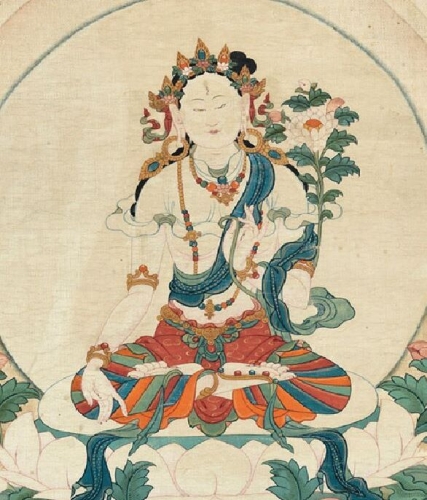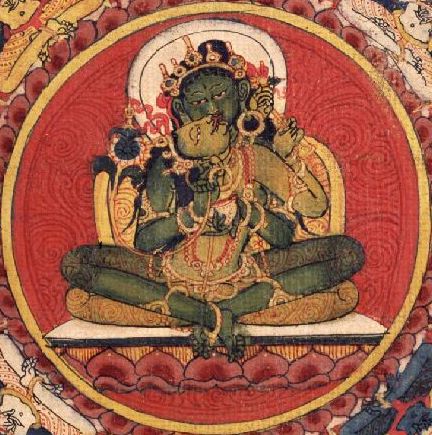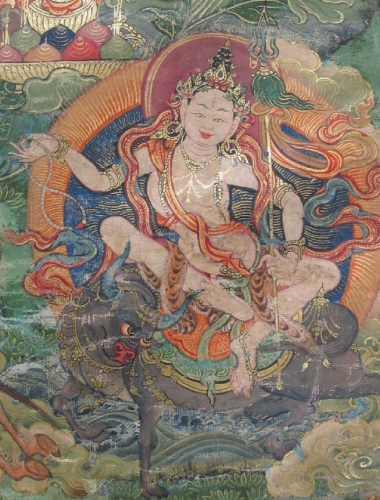Buddhist practice and Buddhist art have been inseparable in the Himalayas ever since Buddhism arrived to the region in the eighth century. But for the casual observer it can be difficult to make sense of the complex iconography. Not to worry—Himalayan art scholar Jeff Watt is here to help. In this “Himalayan Buddhist Art 101” series, Jeff is making sense of this rich artistic tradition by presenting weekly images from the Himalayan Art Resources archives and explaining their roles in the Buddhist tradition.
This week Jeff explains the ubiquitous yet mysterious figure of Tara in Himalayan Buddhist art.
Himalayan Buddhist Art 101: Who is Tara?
 Tara is a name that almost everybody associated with Mahayana Buddhism has heard. But who is Tara? What is Tara?
Tara is a name that almost everybody associated with Mahayana Buddhism has heard. But who is Tara? What is Tara?
Well, according to Vajrayana Buddhism, Tara is a completely enlightened Buddha who made a promise in the distant past that after reaching complete enlightenment she would always appear in female form for the benefit of all beings. By iconographic category and hierarchy Tara is a meditational deity (ishtadevata, yidam) and her appearance is that of a peaceful deity, a Devi or “bodhisattva appearance.” All peaceful deities of the pantheon are characterized as having bodhisattva appearance, which is both an iconographic classification and an artistic one. This is actually one of the main reasons why Tara, because of her appearance, is commonly referred to in the West simply as a bodhisattva.
There are many different forms of Tara.  The most common form is rendered in the color green, which is considered special for all types of activities. The white form of Tara represents longevity and the red form, power. Tara comes in all colors and degrees of wrathfulness, with varying numbers of faces, arms, and legs. There are simple meditational forms depicting a single figure as well as complex forms with sizable retinues filling large mandala configurations. In total, there are likely close to two hundred different meditational forms of the enlightened Buddha Tara. Observed in all schools of Tibetan Buddhism, Tara, among the other deities that constitute the pantheon, is likely second in popularity only to Avalokiteshvara.
The most common form is rendered in the color green, which is considered special for all types of activities. The white form of Tara represents longevity and the red form, power. Tara comes in all colors and degrees of wrathfulness, with varying numbers of faces, arms, and legs. There are simple meditational forms depicting a single figure as well as complex forms with sizable retinues filling large mandala configurations. In total, there are likely close to two hundred different meditational forms of the enlightened Buddha Tara. Observed in all schools of Tibetan Buddhism, Tara, among the other deities that constitute the pantheon, is likely second in popularity only to Avalokiteshvara.
Tara guards against the eight and sixteen fears. Occupying this role, she has taken on many of the early functions originally associated with the deities Avalokiteshvara and Amoghapasha.
 The Eight Great Fears are water, lions, fire, snakes, elephants, thieves, false imprisonment, and ghosts. These are meant literally, though they also point to inner and secret meanings. Tantric Buddhism commonly presents an interpretive model of three levels of meaning: outer, inner, and secret. The outer meaning of the eight fears is exactly what is described above: real fears that were commonly encountered in ancient times and sometimes even today.
The Eight Great Fears are water, lions, fire, snakes, elephants, thieves, false imprisonment, and ghosts. These are meant literally, though they also point to inner and secret meanings. Tantric Buddhism commonly presents an interpretive model of three levels of meaning: outer, inner, and secret. The outer meaning of the eight fears is exactly what is described above: real fears that were commonly encountered in ancient times and sometimes even today.
Meditational practices and visual descriptions of Tara are found in all classes of tantra and in all the various Himalayan and Tibetan Buddhist traditions.
Three forms of Tara are depicted here as examples. The first is White Tara, relating to the prolonging of life. The second is Green Tara in union with Amoghasiddhi Buddha. This form of the couple in union places Tara in the dominant role and the male buddha in the secondary position with back facing the viewer. The third example depicts Tara “accomplishing the complete perfection,” and is of special interest due to her riding a buffalo. This form of Tara belongs to a set of twenty-one Taras that likely originated in Kashmir with the siddha known as Suryagupta.
Learn more about the meditational deity Tara in Himalayan Buddhist art here.
For details on the examples above, follow up on Himalayan Art Resources for White Tara, Tara and Amoghasiddhi, and Tara “Accomplishing the Complete Perfection.”
Thank you for subscribing to Tricycle! As a nonprofit, we depend on readers like you to keep Buddhist teachings and practices widely available.